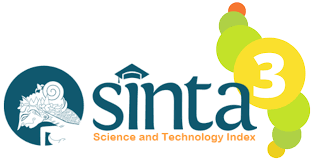LITERATURE REVIEW OF BULLYING ASSESSMENT : A CRITICAL REVIEW OF THE INVENTORY OF BULLYING SCALE IN SCHOOLS
KAJIAN LITERATUR ASSESSMENT BULLYING: TINJAUAN KRITIS TERHADAP INVENTORI SKALA BULLYING DI SEKOLAH
DOI:
https://doi.org/10.36526/sosioedukasi.v12i2.3044Keywords:
Assessment, Bullying, Inventory, SchoolAbstract
Bullying is still a serious problem in Indonesia. The impact of bullying on its victims is very real. Meanwhile, on average, educators, especially guidance counselors, education staff, and parents only become aware of bullying after it has happened. If early detection efforts are made, the case can be anticipated earlier. This is because there are no measurement instruments that can assist the counseling teacher in detecting cases of bullying that occur easily and on a large scale. So it is necessary to digitize the bullying scale instrument. Instruments in the form of self-reports are the most commonly used method in collecting data to assess bullying phenomena. This method has several advantages. The Olweus Bully/Victim Questionnaire (OBVQ) is one of the most widely used instruments to measure the prevalence of bullying worldwide. This questionnaire provides students with a clear definition of bullying that includes three important characteristics: (1) intent to harm others; (2) repetitive behavior; and (3) the power imbalance between victims and perpetrators. The OBVQ can be adapted into a bullying scale inventory that is appropriate to the conditions and culture in Indonesia so that it can be used to detect bullying phenomena that occur in Indonesian youth, especially at school.
References
Crothers, L. M., & Levinson, E. M. (2004). Assessment of bullying: A review of methods and instruments. In Journal of Counseling and Development (Vol. 82, Issue 4, pp. 496–503). Wiley Blackwell. https://doi.org/10.1002/j.1556-6678.2004.tb00338.x
Dhungana, K., Akosua, S., Lisa, K., & Niti, Y. (2022). Bullying ‑ Related Tweets : a Qualitative Examination of Perpetrators , Targets , and Helpers. International Journal of Bullying Prevention, 6–22. https://doi.org/10.1007/s42380-021-00098-3
Gaete, J., Tornero, B., Valenzuela, D., Rojas-Barahona, C. A., Salmivalli, C., Valenzuela, E., & Araya, R. (2017). Substance use among adolescents involved in bullying: A cross-sectional multilevel study. Frontiers in Psychology, 8(JUN), 1–14. https://doi.org/10.3389/fpsyg.2017.01056
Gaete, J., Valenzuela, D., Godoy, M. I., Rojas-Barahona, C. A., Salmivalli, C., & Araya, R. (2021). Validation of the Revised Olweus Bully/Victim Questionnaire (OBVQ-R) Among Adolescents in Chile. Frontiers in Psychology, 12. https://doi.org/10.3389/fpsyg.2021.578661
Gladden, R. M., Vivolo-Kantor, A. M., Hamburger, M. E., & Lumpkin, C. D. (2014). Bullying surveillance among youths. Centers for Disease Control and Prevention Atlanta, Georgia, 4–101.
Green, J. G., Felix, E. D., Sharkey, J. D., Furlong, M. J., & Kras, J. E. (2013). Identifying bully victims: Definitional versus behavioral approaches. Psychological Assessment, 25(2), 651–657. https://doi.org/10.1037/a0031248
Haynie, D. L., Nansel, T., Eitel, P., Crump, A. D., Saylor, K., Yu, K., & Simons-Morton, B. (2001). Bullies, victims, and bully/victims: Distinct groups of at-risk youth. Journal of Early Adolescence, 21(1), 29–49. https://doi.org/10.1177/0272431601021001002
Heerde, J. A., & Hemphill, S. A. (2019). Are Bullying Perpetration and Victimization Associated with Adolescent Deliberate Self-Harm? A Meta-Analysis. Archives of Suicide Research, 23(3), 353–381. https://doi.org/10.1080/13811118.2018.1472690
Jadambaa, A., Thomas, H. J., Scott, J. G., Graves, N., Brain, D., & Pacella, R. (2019). Prevalence of traditional bullying and cyberbullying among children and adolescents in Australia: A systematic review and meta-analysis. Australian and New Zealand Journal of Psychiatry, 53(9), 878–888. https://doi.org/10.1177/0004867419846393
Malta, D. C., Silva, M. A. I., de Mello, F. C. M., Monteiro, R. A., Sardinha, L. M. V., Crespo, C., de Carvalho, M. G. O., da Silva, M. M. A., & Porto, D. L. (2010). Bullying in Brazilian schools: Results from the national school-based health survey (PeNSE), 2009. Ciencia e Saude Coletiva, 15(SUPPL. 2), 3065–3075. https://doi.org/10.1590/s1413-81232010000800011
Midgett, A., & Doumas, D. M. (2019). Witnessing Bullying at School: The Association Between Being a Bystander and Anxiety and Depressive Symptoms. School Mental Health, 11(3), 454–463. https://doi.org/10.1007/s12310-019-09312-6
Modecki, K. L., Minchin, J., Harbaugh, A. G., Guerra, N. G., & Runions, K. C. (2014). Bullying prevalence across contexts: A meta-analysis measuring cyber and traditional bullying. Journal of Adolescent Health, 55(5), 602–611. https://doi.org/10.1016/j.jadohealth.2014.06.007
Nelson, H. J., Burns, S. K., Kendall, G. E., & Schonert-Reichl, K. A. (2018). The Factors That Influence and Protect Against Power Imbalance in Covert Bullying Among Preadolescent Children at School: A Thematic Analysis. Journal of School Nursing, 34(4), 281–291. https://doi.org/10.1177/1059840517748417
Olweus, D. (1993). Bullying at School.pdf. Blackwell.
Polanin, J. R., Espelage, D. L., & Pigott, T. D. (2012). A meta-analysis of school-based bullying prevention programs’ effects on bystander intervention behavior. School Psychology Review, 41(1), 47–65. https://doi.org/10.1080/02796015.2012.12087375
Rahmawati, D., & Retnawati, H. (2021). ANTI-BULLYING AWARENESS OF HIGH SCHOOL STUDENTS IN YOGYAKARTA CITY. PSIKOPEDAGOGIA: Jurnal Bimbingan Dan Konseling, 10(2). https://doi.org/10.12928/psikopedagogia.v10i2.17580
Resett, S. (2011). Aplicación del cuestionario de agresores : víctimas de Olweus a una muestra de adolescentes argentinos. Revista de Psicología. UCA, 7, 13.
Ronan, G. F., Dreer, L., Maurelli, K., Ronan, D., & Gerhart, J. (2014). Practitioner’s Guide to Empirically Supported Measures of Anger, Aggression, and Violence. http://link.springer.com/10.1007/978-3-319-00245-3
Salmivalli, C., & Peets, K. (2009). Bullies, victims, and bully-victim relationships in middle childhood and early adolescence. Handbook of Peer Interactions, Relationships, and Groups, 153361869, 322–340.
Salmivalli, C., & Peets, K. (2018). Bullying and Victimization. Bullying and Victimization, 2018. https://doi.org/10.1542/9781610022880
Saputra, Y. (2022). Perundungan, gim, dan tantangan viral - ‘Sekolah masih tergagap-gagap menghadapi kasus bully’ - BBC News Indonesia. https://www.bbc.com/indonesia/articles/czkdgve3840o
Skapinakis, P., Bellos, S., Gkatsa, T., Magklara, K., Lewis, G., Araya, R., Stylianidis, S., & Mavreas, V. (2011). The association between bullying and early stages of suicidal ideation in late adolescents in Greece. BMC Psychiatry, 11, 23–25. https://doi.org/10.1186/1471-244X-11-22
Smith, P. K., Kwak, K., & Toda, Y. (2016). School Bullying in Different Cultures. School Bullying in Different Cultures. https://doi.org/10.1017/cbo9781139410878
Solberg, M. E., & Olweus, D. (2003). Prevalence Estimation of School Bullying with the Olweus Bully/Victim Questionnaire. Aggressive Behavior, 29(3), 239–268. https://doi.org/10.1002/ab.10047
Syajuananda, D. P., & Tirtayani, L. A. (2022). Survei Pengetahuan Guru Mengenai Tindakan Bullying di Taman Kanak-Kanak Kecamatan Denpasar Barat. Jurnal Pendidikan Anak Usia Dini Undiksha, 10(2), 245–254. https://doi.org/10.23887/paud.v10i2.48857
Syarifah. (2022, November 22). Indonesia Peringkat Kelima Kasus Bullying pada Anak dan Remaja - Chatnews Indonesia. Chatnews.Id. https://chatnews.id/read/indonesia-peringkat-kelima-kasus-bullying-pada-anak-dan-remaja
van Aalst, D. A. E., Huitsing, G., & Veenstra, R. (2022). A Systematic Review on Primary School Teachers’ Characteristics and Behaviors in Identifying, Preventing, and Reducing Bullying. International Journal of Bullying Prevention 2022, 1–14. https://doi.org/10.1007/S42380-022-00145-7
Vessey, J., Tania D. Strout, Rachel L. DiFazio, & Allison Walker. (2014). Measuring the Youth Bullying Experience : A Systematic Review of the Psychometric. Journal of School Health, 84(12).









.png)

















